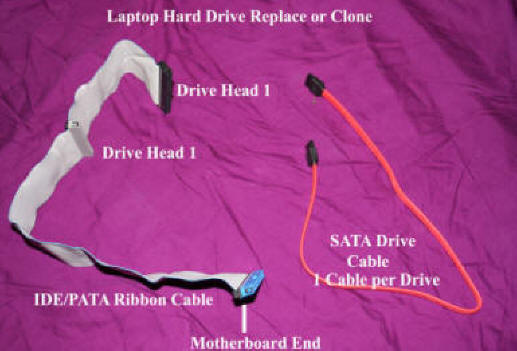
"How to: Clone a Laptop Hard Drive (PATA)"
By Ron Stultz
30 November 2009
A clone operation of a laptop hard drive is applicable if the hard drive is operating properly but is simply no longer has enough room for all your programs and data. A clone operation saves you from having to reload the operating system, all programs and your data.
Before cloning a laptop hard drive, check the entire disk via Windows Scandisk and also check it for virus's and spyware. If a scan disk operation displays bad sectors, your drive is failing and you might better consider a replacement instead of a clone operation.
" How to: Replace a Laptop Hard Drive "
First determine the type of hard drive installed in your laptop. The clone instructions below are for a PATA hard drive.
" How to: Locate and Determine What Type of a Hard Drive is Installed in a Laptop "
" How to: Clone a Laptop Hard Drive (SATA) "
Tools and Skills needed:
- Desktop PC with CD-ROM drive. The clone methodology defined below requires the use of a desktop computer with a built-in CD-DVD reader. If you do not have a desktop personal computer (PC), look into procuring one of the USB based cloning tools.
- Desktop with 2 IDE channels. The clone methodology defined below requires a desktop with (2) IDE channels. If your desktop only supports SATA drives, consider one of the USB cloning tools or consider procuring a SATA-to-IDE converter (shown below). The image below shows what PATA (IDE) and SATA hard drive cables look like. Older desktops may only support PATA drives while new desktops, only support SATA drives. In my case, my motherboard has (2) IDE channels and (2) SATA ports.

.jpg)
- IDE cables and master\slave jumpering. The clone methodology defined below requires you to open a desktop PC and unhook all hard drives currently in the system (You do this to get access to the drive cable and to protect your desktop drives from accidental cloning). It also requires you to perhaps set a master\slave jumper on the desktop's CD-DVD reader. If you are not familiar with IDE cables and device master\slave jumpers, I suggest you try a computer retailer service center. I do not know if they will perform a clone operation for you or not.
- Special laptop IDE connectors. Because a laptop drive is smaller than what is installed in a desktop, you will need special adapters, which allow you to electrically connect a laptop drive to the IDE cable found in desktops. (Special connectors cost about $10 and available on eBay and computer stores.) These connectors are "keyed", meaning they will only go onto the hard drive one way. Look for the "key", which is a missing pin on the IDE connector. The IDE cables in your desktop may or may not be keyed. Old cables do not have a key. If keyed, no problem. If not keyed, see if you can determine "pin 1" on the hard drive and attach the special hard drive adapter to the IDE cable such that pin 1 on the hard drive is on the same side of the IDE cable as the red wire or stripe. The red wire on IDE cables signifies "pin 1."
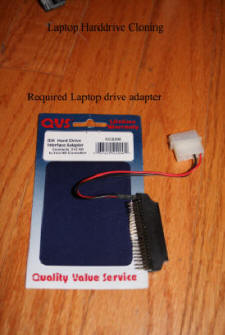
- (2) IDE cables, 1 with dual heads. If your desktop PC has a single IDE cable or 2 IDE cables but both are only single-headed (can only connect one device to each) you are going to have to procure a second IDE cable with 2 drive connectors on it. This cable is available on Ebay or at most retailers that sell computer components. Expect to pay $8.
- A small Phillips screwdriver. You will need one that is not worn out but rather has nice sharp edges at the point.
- Needle nose pliers.
- Cloning software. There are many Internet-based sources for this software. I have tried free versions and have found them lacking in one or more features I needed. Expect to pay $30 - $50 for cloning software and this is for a download you will eventually have to burn to a CD. And "NO" you can not simply do a Windows copy of one drive to another. You must have cloning software.
Use the following as guidance in cloning a PATA (IDE) laptop hard drive:
1. Laptop drive out of laptop. At this point, you should have read "How to: Locate and Determine What Type of Hard Drive is Installed in a Laptop" and have the hard drive out of your laptop. You should also have procured a new hard drive to which you are going to clone the old drive.
2. Open desktop and unhook current drives.With desktop powered "off" and power cord unhooked from back of desktop, remove IDE cables from hard drives. If you have to replace any IDE cables, do so now.
3. Set CD-ROM master\slave jumper to "slave." If you are lucky, you will be able to do this without removing the drive from you desktop. Usually, the jumper on the back of the unit is set to "slave" if the CD-ROM shares an IDE cable with a hard drive or "master" if it is the only drive on an IDE cable. Usually, there are 4 sets of pins on the master\slave connector on the back of the unit. The first 2 pins are used for "master" and the second 2 for "slave." With an Exacto knife, flashlight and needle nose pliers, you should be able to set the jumper to the second set of pins if jumper is currently configured for "slave."
4. Attach special connectors to both laptop drives. The special IDE connectors required to allow you to connect a laptop to a desktop IDE cable should be "keyed" such that there is a missing pin on the laptop drive connector and on the special connector. Be very careful placing the special connector on the laptop drives. It is not necessary to mount the laptop drives in the desktop. Laptop drives are so light that they can dangle from the IDE cable.
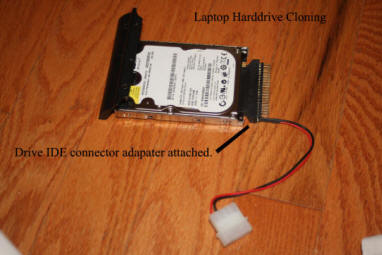
5. Attach on laptop drive to the IDE cables. Attach one laptop drive to the IDE channel cable being shared with the CD-ROM. It does not matter which drive is connected to which IDE channel or cable. Attach the second drive to the other IDE cable. If the second IDE cable has 2 connector heads on it, connect the drive to the drive connector closest to the motherboard. The IDE cables should be "keyed" such that you can not place the special laptop connector on the cable just one way but on older desktops it is possible to find IDE cables that do not have "keys" or a missing pin in the center of the connector. In this case, try to find pin 1 on the laptop drive and connect the drive to the IDE cable so pin 1 of the drive is on the same side of the IDE cable as the outer most red wire.

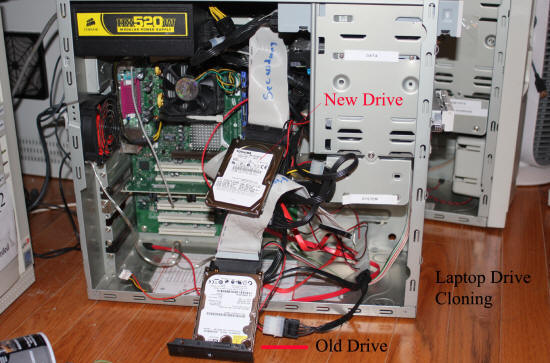
6. Connect a device power connector to both laptop drives. To do this, if your desktop has a limited number of device power connectors, you might have to remove the power connect from your desktop drive or perhaps procure a power splitter.

7. Write down the model of the original laptop drive. When you clone, you need to know which is the original drive and cloning software is only going to tell you a model number.
8. Check over all electrical, mechanical connections\connectors. Best at this point to take a break and go outside or do something else for 10 - 15 minutes. Then when you come back, check the entire insides of your desktop. No wires going to be caught in a fan? All connectors on tight?
9. Plug the power cord into the power supply of the desktop. The desktop may come alive for a second or 2 but then power down.
10. Use the "on" button to power up the desktop.
11. Now begin pushing the function key or keys required to get your desktop into the BIOS.
12. Insert cloning software CD into desktop CD-ROM reader. When the BIOS main menu screen is on your desktop display, insert cloning software into your CD-ROM and close the tray. The cloning software will not start at this time.
13. Verify that the laptop drives and CD-ROM are being seen by the BIOS. It will depend on your specific desktop's BIOS, but you should be able to tab along the main menu at the top of the BIOS until you see a submenu for "drive configuration." Select this option and verify the the desktop BIOS is seeing both laptop drives and your CD-ROM. If one or more drives is not present, shut down the system and check that the laptop drives are correctly connected to the IDE cable and that the power connector to the 2 laptop drives and CD-ROM are present and tight. Once you are done verifying that both drives and the CD-ROM are being seen by the desktop BIOS, escape key back to the main menu.
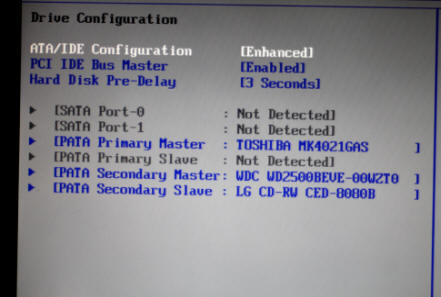
14. In the BIOS, change the device boot order. You now have 2 laptop drives and a CD-ROM active on your desktop and you are almost ready to run the cloning software but first you must change to desktop boot order to the CD-ROM as the first device. On the main BIOS menu, you should be able to tab over to "Boot" and then on the submenu change the first boot device to your CD-ROM. Change the second device to the floppy drive. Once you have changed the boot order, escape key back to the main menu.
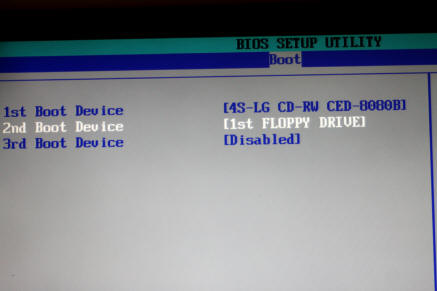
15. Save the current BIOS settings. Tab over along the main BIOS menu to the "Save & Exit" menu bar. Then select "Save and Exit."
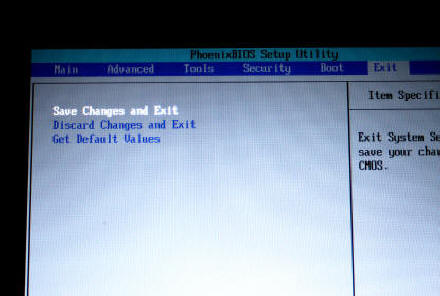
15. The cloning software should now start. Once you do a "Save and Exit", our desktop will restart and begin executing the cloning software on the CD inserted into your CD-ROM. If the clone software does not start or you receive any sort of error, shut down the system and verify that the CD of cloning software is valid.
16. Follow cloning software instructions. Here you will be asked to define the source disk and the target disk. And you will be given an opportunity to have the original OS expand into all the space on the target drive. If you wish to divide the target drive into 2 or more smaller drives, you should have the ability to do so in your cloning software options.
.jpg)
.jpg)
17. Shut down desktop. When the cloning software has completed (may take a few minutes or hours depending on the size of the original laptop drive) shut down your system. You can use the switch on the power supply if you have on to do this.
18. Remove the new laptop hard drive from the desktop. Remove the new laptop drive from the desktop and if a caddy is used, install new laptop drive in caddy and install any special connectors.
19. Install new drive in your laptop.
20. Power on the laptop. The laptop should now come alive with the OS you cloned from the old drive.
21. Run a scandisk. If all appears well, run a Windows scandisk operation. Select the option to completely scan the entire drive included unused space.
22. Remove the original laptop drive from the desktop. Remove the original drive from the desktop and place it a safe place. Do not format or sell or give it away, just yet.
23. Reconnect desktop hard drives.
24. Change jumper on CD-ROM. If you had to change the jumper on the CD-ROM drive to slave from master, change it back now.
25. Check all desktop connections.
26. Power up your desktop.
27. All complete. Hold on to your original drive for a couple of weeks in case your new drive decides to go bad on you.
28. Make a data backup. If you have not done so in a while, make a CD or DVD backup of data on your laptop drive.